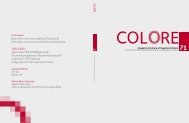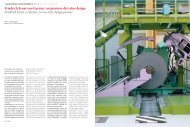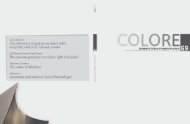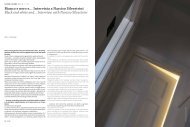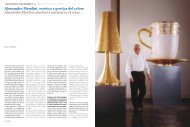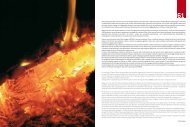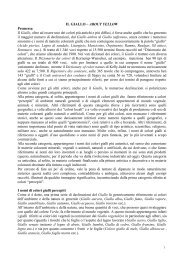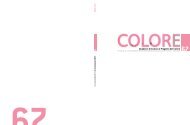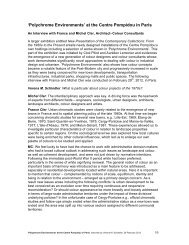Quaderni di Cultura e Progetto del Colore - Istituto Del Colore
Quaderni di Cultura e Progetto del Colore - Istituto Del Colore
Quaderni di Cultura e Progetto del Colore - Istituto Del Colore
Create successful ePaper yourself
Turn your PDF publications into a flip-book with our unique Google optimized e-Paper software.
CULTURA / CULTURE [ 1 2 3 4 5 6 ( 7 + 8 ) 9 ]<br />
.perchè considerarlo più recente <strong>del</strong> porpora ( o violetto)<br />
e <strong>del</strong> marrone?<br />
Ancora nel 1969, Berlin e Kay <strong>di</strong>mostravano che le<br />
un<strong>di</strong>ci categorie <strong>di</strong> base si trovano in tutte le lingue,<br />
con la stessa frequenza, ovviamente nei paesi che<br />
hanno raggiunto i settimo grado <strong>del</strong>l’evoluzione<br />
Il contatto con la Scienza <strong>del</strong>la Visione avveniva nel<br />
1955, con Hurvich e Jameson, che introducevano<br />
nell’antropologia le certezze <strong>del</strong>l’organizzazione<br />
antagonista nel processo visivo <strong>del</strong> colore. Alla<br />
fine degli anni Sessanta, si concretizzò il contatto<br />
con Boynton e la sua scuola. Dalla collaborazione<br />
nacque lo spazio percettivo, che racchiudeva le<br />
categorie <strong>del</strong> colore, cioè <strong>del</strong>le regioni attorno al loro<br />
centroide (il punto rappresentativo <strong>del</strong>la me<strong>di</strong>a<br />
pesata), ciascuna riferita ad un dato colore <strong>di</strong> base,<br />
cioè, saliente e molto saturo.. Allontanandosi<br />
dal colore focale (cioè quello che più rappresenta il<br />
nome assegnato alla categoria coinvolta), l’aspetto<br />
<strong>del</strong> colore cambia, soprattutto in saturazione, e la<br />
nomenclatura varia, per esempio, come prima abbiano<br />
riportato, per il colore marrone , nel paragrafo<br />
3. Alcune regioni si sovrappongono parzialmente,<br />
altre no, ma la transizione è affidata ai cosiddetti<br />
“ponti” <strong>di</strong> collegamento. Per esempio, l’arancio è un<br />
ponte fra rosso e giallo; il giallo fa da ponte fra aran-<br />
occurrence in every language of the countries which<br />
have been reaching the 7th degree of evolution.<br />
In turn, Jameson and Hurvich contacted the anthropologists,<br />
by facing them with the peculiarities<br />
of the color opponent organization. At the end<br />
of the sixties, the contact with Boynton and his<br />
school led to the formulation of the perceptual categorical<br />
space, That is, this space contains regions,<br />
each correspon<strong>di</strong>ng to a given basic category, that<br />
is, to a salient and highly saturated color. The focal<br />
color is that which best represents the color name<br />
assigned to each category, By increasing the <strong>di</strong>stance<br />
from the focal color, the percepts change in<br />
appearance,and, mainly for brown, saturation descreases,<br />
Various intra-categorical names are met<br />
by navigating across each region.<br />
Some regions are partially overlapping, allowing<br />
the transition from one category to the nearby ones.<br />
Other regions do not overlap, but the intercategory<br />
transition is allowed thanks to the existence of the<br />
so-called bridges. For instance, orange involves a<br />
bridge connecting red and yellow; similarly, yellow<br />
for orange and green, and so on.<br />
The basic categories are characterized by a single<br />
name, that is, they are monolexemic. The points representative<br />
of the non-basic categories (double, com-<br />
cio e verde, e così via. Le categorie <strong>di</strong> base sono caratterizzate<br />
da un nome unico e, in inglese, sono<br />
pertanto dette monolexemic. Fra le regioni riferite<br />
alle categorie <strong>di</strong> base cadono i nomi non monolexemic,<br />
ma doppi o tripl, cioè, composti, dei colori “non<br />
<strong>di</strong> base”. Esiste infine una particolare zona, nella<br />
mappa percettiva <strong>del</strong> colore, quella in cui cadono i<br />
colori che non hanno un nome ufficiale, es. salmone,<br />
pesca, sabbia, abbronzatura. O si considerano<br />
degli “apoli<strong>di</strong>” o si aggregano in una do<strong>di</strong>cesima<br />
categoria <strong>di</strong> base. Può essere interessante notare<br />
che, proprio alcuni <strong>di</strong> questi nomi sono anche nella<br />
lista dei nomi (es. nel free naming) che sono considerati<br />
come varianti <strong>del</strong> marrone, nonostante che<br />
esso, in un’altra zona <strong>del</strong>la mappa percettiva, abbia<br />
localizzata la sua personale categoria.<br />
La mappa sinora considerata si riferisce ad una sezione<br />
orizzontale <strong>del</strong> solido <strong>del</strong>la percezione <strong>del</strong> colore.<br />
Va tenuto presente, che non si può avere su<br />
uno stesso piano tutto l’insieme dei colori <strong>di</strong> base,<br />
che sono <strong>di</strong>stribuiti in vari piani, a <strong>di</strong>verse altezze,<br />
lungo l’asse <strong>del</strong>la brillanza. Per esempio, il<br />
giallo,l’arancio ed il rosa si trovano esclusivamente<br />
alle brillanze elevate. Invece, il violetto, il marrone<br />
ed anche il rosso occupano, inevitabilmente, i<br />
piani più bassi..<br />
Nonostante il successo <strong>del</strong>la proposta <strong>di</strong> Boynton,<br />
nella letteratura troviamo svariate altre proposte.<br />
Per esempio, Jameson e D’andrade propongono<br />
una sud<strong>di</strong>visione in due parti <strong>del</strong> solido dei colori.<br />
Da un lato, i colori scuri e fred<strong>di</strong>, dall’altro lato i colori<br />
chiari e cal<strong>di</strong>.<br />
In conclusione, il tema riguardante l’aspetto de colore,<br />
le sue denominazioni e relativi problemi è molto<br />
vasto, ed ancora oggetto <strong>di</strong> <strong>di</strong>scussioni e polemiche.<br />
In particolare qualcuno afferma che “ il<br />
problema <strong>del</strong>la relazione fra grigio , violetto ( o porpora)<br />
e marrone è ancora insoluto”.<br />
.<br />
5. Verso la Psicologia ed oltre<br />
Hunt afferma che “ benché il colore si possa definire<br />
in termini <strong>di</strong> quantità fisiche, quali la trasmissione<br />
spaziale e le curve <strong>di</strong> trasmissione, la mente<br />
umana interviene sulle sensazioni, e dobbiamo<br />
considerare sia l’aspetto fisico, sia l’aspetto psicologico”.<br />
Per questo, nel suo libro, dove si trattano<br />
questioni strettamente tecniche, Hunt de<strong>di</strong>ca ampio<br />
spazio, per esempio, alle preferenze in<strong>di</strong>viduali<br />
ed alle conseguenze <strong>di</strong> quello che l’osservatore<br />
si aspetta, quando deve esprimere un giu<strong>di</strong>zio sulla<br />
qualità <strong>di</strong> una riproduzione. Per esempio, viene<br />
descritta una tecnica applicata alla riproduzione <strong>di</strong><br />
una scena complessa, con svariati oggetti <strong>di</strong>versi.<br />
posite names) fall in the intercategorical spaces.<br />
At last, a peculiar area exists in the perceptual color<br />
map, where the colors devoid of an official name are<br />
located, like salmon, peach sand, tan. There are two<br />
possibilities, either such colors are treated in isolation,<br />
or they are covered by a new, 12rh category.<br />
Note that some names like sand and tan, in a free<br />
naming, are regarded as versions of brown, in spite<br />
of the fact that borwn has, elsewhere in the map,<br />
the location of its personal category.<br />
The above described perceptual map represents<br />
an horizontal section of the related color solid. Note<br />
that all the basic categories cannot be located in<br />
the same, constant lightness map. Various basic<br />
colors are <strong>di</strong>stributed in <strong>di</strong>fferent planes, at <strong>di</strong>fferent<br />
heights along the vertical axis. For instance,<br />
yellow, pink and orange are exclusively found at<br />
high luminances. Instead, violet, brown and red are<br />
located in the lower planes.<br />
In spite of te success of Boynton’s study, various<br />
other proposals are found in the literature. For instance,<br />
Jameson and D’Andrade suggest partitioning<br />
the perceptual color solid into two parts: on one<br />
side, the dark, cool colors; on the other side, the<br />
bright, warm colors..<br />
In conclusion, the theme concerning color appearance,<br />
the related names and problems, is rather<br />
complex and yet debite .In particular, somebody<br />
believes that the relation between grey, violet (or<br />
purle) and brown is still a mystery to be made clear.<br />
5 Towards Psychology and beyond<br />
Accor<strong>di</strong>ng to Hunt, “although the color may be defined<br />
in physical terms , the human mind controls<br />
the situation, so that both the physical and psychological<br />
aspects should be considered together”.<br />
For this, Hunt devotes a wide space of his book to<br />
the preferences and to the expectations of the observers<br />
faced with the evaluation of the quality of<br />
a reproduction. For instance, a peculiar technique<br />
may be applied to the reproduction of a complex<br />
scene. That is, the local luminance and contrast<br />
of every ingre<strong>di</strong>ent belonging to the scene may be<br />
locally modulated, independently from the others<br />
and optimized, so that the global image is satisfactory<br />
under every respect.<br />
At last, let us recall that Mahnke considers the brown<br />
color as a dark orange, devoid of a spectral counterpart,<br />
but psychologcally linked wth comfort and<br />
stability, motherly and dependable. However, some<br />
brown nuances appear glum, grubby and drub.<br />
Mahnke repots the results of the researches made<br />
in the best Psychological schools, for instance in<br />
A proposito <strong>del</strong> marrone ... / About the ubiquitous...<br />
16 COLORE COLORE 17



